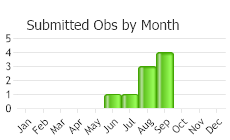View in other NatureServe Network Field Guides
NatureServe
Montana
Utah
Wyoming
Idaho
Wisconsin
British Columbia
South Carolina
Yukon
California
New York
Toothy Torncap Moss - Codriophorus acicularis
Other Names:
Racomitrium aciculare
General Description
Plants: Acrocarpous (Vitt 1988). Growing in open tufts or in mats (FNA 2007), deep green (Crum & Anderson et al. 1981) or reddish-green to yellow above, somewhat russet to brown or black below or occasionally all over. Stems creeping to curving upward, 1-15 cm tall, the branches sometimes growing in clusters, or numerous from profuse dichotomous forking (FNA 2007).
Leaves: Loosely upright or overlapping, frequently curving to one side when dry, spreading somewhat when moist (Crum & Anderson et al. 1981), 1.5-3.2 mm in length (FNA 2007), 0.9-1 mm in width (Lawton 1971), tongue-shaped to egg- or lance-shaped, sometimes widely so; margins flat to a little curved up and inward above, curved back and down in the bottom half, smooth most of the way to the apex, there raggedly toothed to wavy; apex acute to widely curved, obtuse, and lacking a point; costa broad, nearly reaching the leaf tip, sometimes with a short split at the apex (FNA 2007).
Leaf Cells: Margins of 1 cell layer; costa in X-section of 3-6 cell layers (seldom 7-layered) above, 2-3 layers proximally (FNA 2007), the cells of the adaxial layer frequently larger (Lawton 1971), with a wide-angled channel above the costa on the ventral leaf surface, convex and somewhat flattened or crescent-shaped on the dorsal surface; laminal cells with thick, wavy walls, the upper laminal cells 1-layered, seldom 2-layered, sometimes bearing papillae (FNA 2007), frequently isodiametric, becoming longer in the leaf’s middle; basal laminal cells long and slender, with very thick, wavy walls (Lawton 1971).
Range Comments
North American Range
Canada: YT and BC, ON to NL and NS; USA: AK, WA, CA, ID, NV, AZ, OK and AR, in the Rockies of MT and CO, MN, WI and MI, extending e to the coast and ne to ME from KY, TN, and AL; isolated in AR, OK, and CO (FNA 2007). Known in Montana from Flathead, Glacier, Ravalli, and Sanders Counties (Elliott 2016).
Observations in Montana Natural Heritage Program Database
Number of Observations: 9
(Click on the following maps and charts to see full sized version)
Map Help and Descriptions
Relative Density

Recency



 (Observations spanning multiple months or years are excluded from time charts)
(Observations spanning multiple months or years are excluded from time charts)
Habitat
Damp to wet rocks, usually acidic and canopied, in or near streams, lakesides, frequently constantly underwater in rapids or waterfalls. Elevation: 0-10,830 feet (FNA 2007).
Reproductive Characteristics
Dioicous (Lawton 1971). Interior perichaetial leaves transparent or slightly yellow, sometimes with chlorophyll in the incrassate cells above (FNA 2007); perichaetial leaves 1.6-3.2 mm in length, longer than the perigonial leaves, the costa short to long, and laminal cells only a little wavy (Lawton 1971). Seta 1.8-17 mm tall, russet to black (FNA 2007), spiraled clockwise (Lawton 1971). Capsule 1-3.1 mm in length, brown; peristome teeth split once or twice about 1/2-2/3 of their length, ochre to russet, thick with short, minute papillae (FNA 2007).
Stewardship Responsibility
References
- Literature Cited AboveLegend:
 View Online Publication
View Online Publication Elliott, J.C. and A.K. Pipp. 2018. A Checklist of Montana Mosses (1880-2018). Updated 3 January, 2020. Montana Natural Heritage Program, Helena, Montana. 73 pp.
Elliott, J.C. and A.K. Pipp. 2018. A Checklist of Montana Mosses (1880-2018). Updated 3 January, 2020. Montana Natural Heritage Program, Helena, Montana. 73 pp. Flora of North America Editorial Committee, eds. 2007. Flora of North America North of Mexico. Volume 27. Bryophytes: Mosses, Part 1. Oxford University Press, Inc., NY. xxi + 713 pp.
Flora of North America Editorial Committee, eds. 2007. Flora of North America North of Mexico. Volume 27. Bryophytes: Mosses, Part 1. Oxford University Press, Inc., NY. xxi + 713 pp. Lawton, E. 1971. Moss Flora of the Pacific Northwest. Hattori Botanical Laboratory. Japan: Yamabuki-cho, Shinjuku-ku, Tokyo. 362 pages plus appendices.
Lawton, E. 1971. Moss Flora of the Pacific Northwest. Hattori Botanical Laboratory. Japan: Yamabuki-cho, Shinjuku-ku, Tokyo. 362 pages plus appendices. Vitt, D. J. Marsh, and R. Bovey. 1988. Mosses, Lichens & Ferns of Northwest North America. Seattle, WA: University of Washington Press. 296 p.
Vitt, D. J. Marsh, and R. Bovey. 1988. Mosses, Lichens & Ferns of Northwest North America. Seattle, WA: University of Washington Press. 296 p.
- Additional ReferencesLegend:
 View Online Publication
View Online Publication
Do you know of a citation we're missing? Crum, H.A. and L.E. Anderson. 1981. Mosses of Eastern North America. 2 volumes. Columbia University Press, New York. 1328 pp.
Crum, H.A. and L.E. Anderson. 1981. Mosses of Eastern North America. 2 volumes. Columbia University Press, New York. 1328 pp. Elliot, J. C. 1993. Second checklist of Montana mosses. Unpublished report. U.S. Forest Service, Region 1. Missoula, MT. 45 pp.
Elliot, J. C. 1993. Second checklist of Montana mosses. Unpublished report. U.S. Forest Service, Region 1. Missoula, MT. 45 pp. Lawton, E. 1971. Keys for the Identification of the Mosses on the Pacific Northwest. Reprinted from 'Moss Flora of the Pacific Northwest'. Published as Supplement No. 2 of the Journal of the Hattori Botanical Laboratory. Nichinan, Miyazaki, Japan. 66 pp.
Lawton, E. 1971. Keys for the Identification of the Mosses on the Pacific Northwest. Reprinted from 'Moss Flora of the Pacific Northwest'. Published as Supplement No. 2 of the Journal of the Hattori Botanical Laboratory. Nichinan, Miyazaki, Japan. 66 pp. Malcolm, B., N. Malcolm, J. Shevock, and D. Norris. 2009. California Mosses. Nelson, New Zealand: Micro-Optics Press. 430 pp.
Malcolm, B., N. Malcolm, J. Shevock, and D. Norris. 2009. California Mosses. Nelson, New Zealand: Micro-Optics Press. 430 pp. Smith, A.J.E. 1980. The Moss Flora of Britain and Ireland. Cambridge University Press, Cambridge. 705 pp.
Smith, A.J.E. 1980. The Moss Flora of Britain and Ireland. Cambridge University Press, Cambridge. 705 pp.
- Web Search Engines for Articles on "Toothy Torncap Moss"





